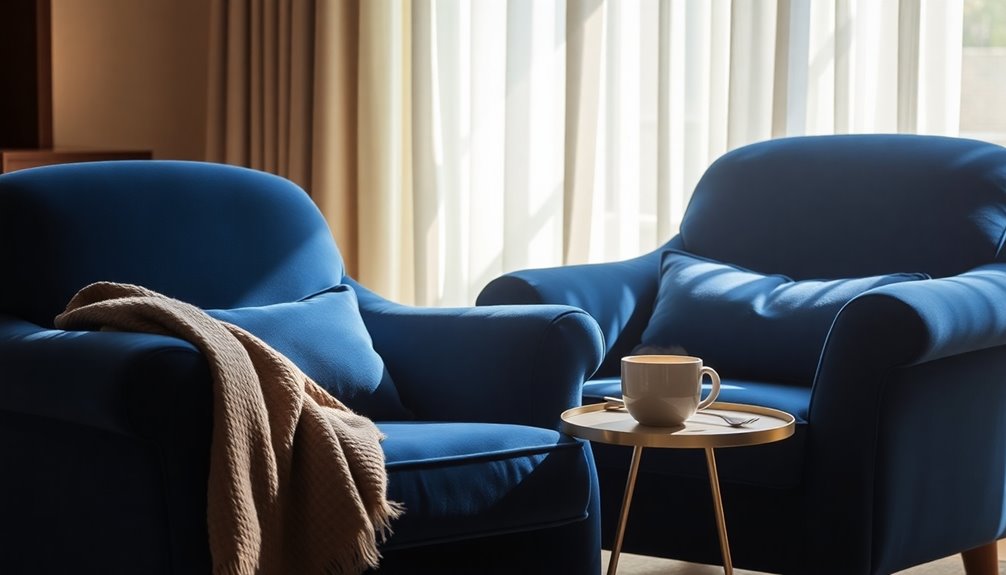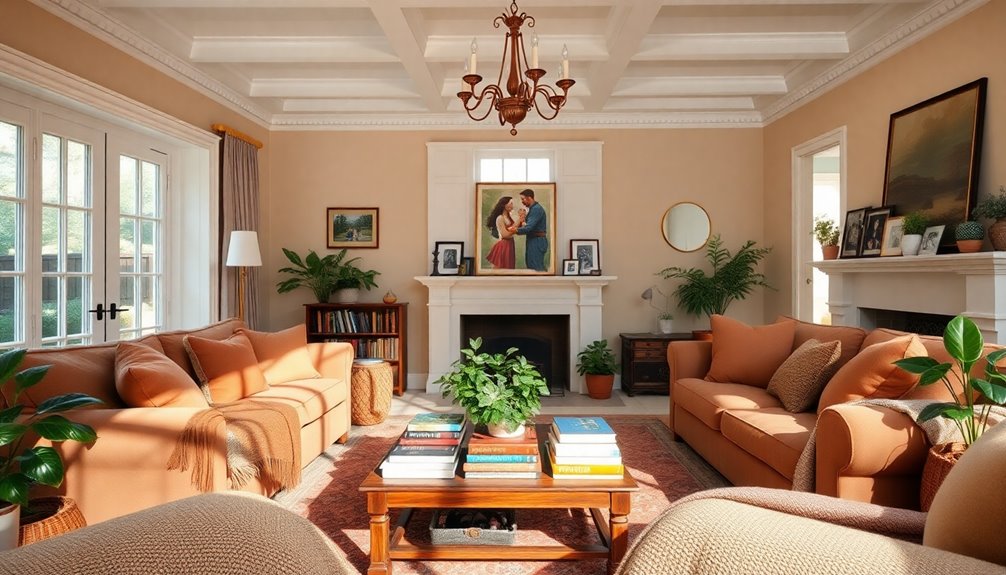As you step into your home, do you feel a sense of comfort and peace, or is it just a collection of items that don’t truly resonate with you? Imagine transforming your space into a sanctuary, not just for yourself but for our planet. It’s time to embrace the beauty of sustainable and eco-friendly interiors, where design meets responsibility. With indoor pollution levels often 2 to 5 times higher than outside, prioritizing air quality is essential for your family’s health1. Sustainable interior design doesn’t just transform your surroundings; it creates a space filled with mindfulness and positivity, allowing you to breathe easier, literally and emotionally.
Integrating sustainable materials and energy-efficient solutions into your home isn’t merely an option; it’s a necessity for a greener future. It’s a beautiful balancing act between creating aesthetically pleasing environments and making environmentally conscious choices that benefit not just your home, but the planet itself. By opting for green interior design practices, you actively participate in the fight against wastefulness, knowing that 80% of furniture and furnishing waste ends up in landfills1. Embracing sustainable home decor means prioritizing quality and longevity—elements that can enhance the mood and productivity within your home environment.
Key Takeaways
- Sustainable interiors focus on using eco-friendly materials like bamboo and recycled glass2.
- Energy-efficient lighting and appliances can significantly reduce utility bills2.
- Adopting low-VOC paints and natural materials improves indoor air quality2.
- Investing in sustainable options often leads to lower long-term costs due to their durability2.
- Incorporating natural light and greenery enhances well-being and productivity2.
- Your choices can directly impact reducing indoor pollution and carbon emissions1.
What Are Sustainable and Eco-Friendly Interiors?
Sustainable and eco-friendly interiors prioritize reducing negative environmental impacts through thoughtful and innovative design choices. This involves using materials and practices that are renewable, non-toxic, and responsibly sourced, aligning perfectly with eco-conscious design concepts. As sustainable interior design emerges as a prominent trend this decade, many interior designers still face challenges due to a limited understanding of sustainable practices3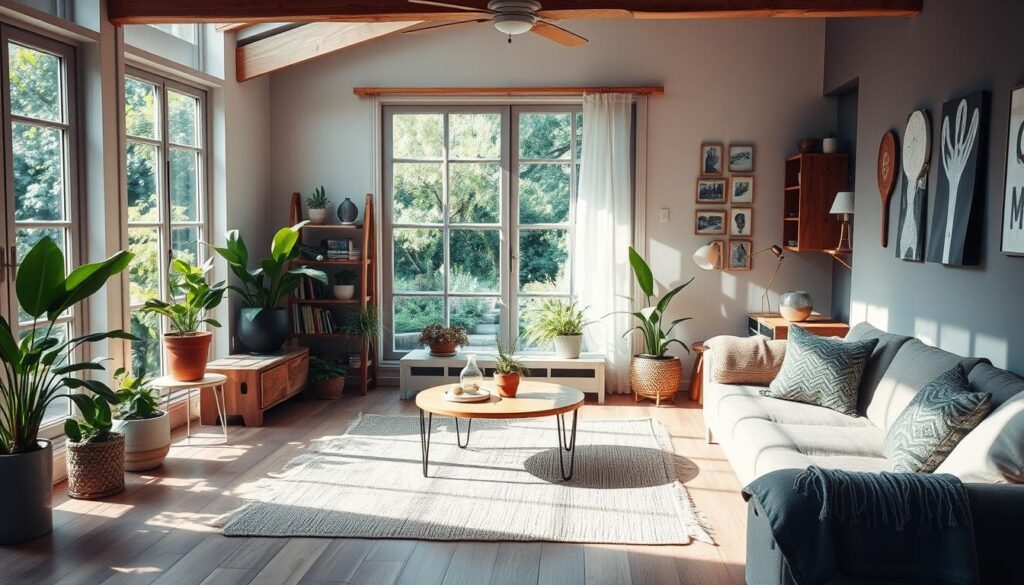
Understanding Sustainability in Design
Incorporating sustainable materials is vital for creating green home interiors. Materials such as bamboo and reclaimed wood stand out for their energy-efficient properties. Bamboo grows rapidly, requiring less energy to produce compared to traditional wood, establishing it as a resource-friendly choice3. Reclaimed wood, often sourced from old warehouses or railway sleepers, adds charm and warmth while ensuring sustainability3. Glass, a recyclable material, also serves decorative purposes, adding a delicate touch to interiors3.
The Importance of Eco-Friendly Choices
Making eco-friendly choices contributes to a healthier living environment by ensuring the materials used are safe and sustainable. For instance, options like low-VOC paints, natural textiles, and energy-efficient appliances support better indoor air quality and reduce waste4. As sustainable design practices become the standard in the industry, designers are turning toward using biodegradable materials and durable furniture4. Emphasizing sustainability in your interior not only benefits the environment but also enhances your personal living space.
Benefits of Sustainable Interior Design
Embracing sustainable interior design offers a wealth of benefits that positively impact you and the environment. Not only do these practices enhance your living space, but they also foster healthier and more eco-friendly living conditions. Here are some vital advantages that come with adopting sustainable interior furnishings in your home.
Healthier Living Environments
Creating an eco-friendly living space directly contributes to improved indoor air quality. This can be achieved through the use of non-toxic paints, such as low-VOC options, and natural textiles, which mitigate the risk of respiratory ailments and allergies. In fact, sustainable interior design aids in improving indoor air quality by using low-VOC materials and promoting energy-efficient solutions, which ultimately lead to healthier living spaces56.
Reduced Environmental Impact
Another essential benefit is the reduction in your overall environmental footprint. By utilizing renewable resources and embracing recycled materials, sustainable interior design promotes practices that minimize waste and lower carbon emissions. For instance, using materials like bamboo and reclaimed wood not only beautifies your home but significantly cuts down your contribution to environmental degradation. The incorporation of energy-efficient systems for lighting and climate control further amplifies this impact56.
Enhanced Aesthetic Appeal
Sustainable interior design merges functionality with beauty, resulting in aesthetically pleasing spaces that reflect your unique style while prioritizing eco-consciousness. By selecting furnishings that are both sustainable and stylish, you can create an inspiring environment that invites creativity and comfort into your everyday life. Utilizing natural materials like rattan and natural stone fosters a warm, rustic aesthetic that can transform any room into a comforting retreat56.

Key Principles of Sustainable Design
In the realm of green interior design, key principles guide how you can create a more sustainable and aesthetically pleasing environment. By focusing on resource efficiency, waste reduction, and an emphasis on quality, you can transform your space into an example of environmentally conscious home decor.
Resource Efficiency
Resource efficiency is the foundation of sustainable interior furnishings. It involves selecting materials that not only minimize environmental impact but also enhance thermal efficiency. For instance, carpets made from ECONYL® nylon yarn, sourced from discarded materials such as fishing nets and plastics, serve as excellent thermal insulators, retaining up to 10% of a room’s heat7. This principle helps conserve energy and promotes sustainability throughout your home.
Waste Reduction
Effective waste reduction strategies are crucial for achieving sustainable design. You can minimize excess by repurposing materials that would otherwise end up in landfills. For example, the production process of ECONYL® nylon yarn eliminates waste by turning discarded items into new fibers without compromising quality7. Embracing these practices can significantly lower the ecological footprint of your living spaces.
Emphasis on Quality
Choosing high-quality materials is key to long-lasting, sustainable designs. Products that are durable and easy to maintain, such as those made with Desso’s AirMaster carpet tiles, not only enhance your home’s aesthetic but also reduce the need for frequent replacements7. As a result, you will consume less and generate less waste over time, aligning perfectly with your goals of creating an environmentally conscious home decor environment.
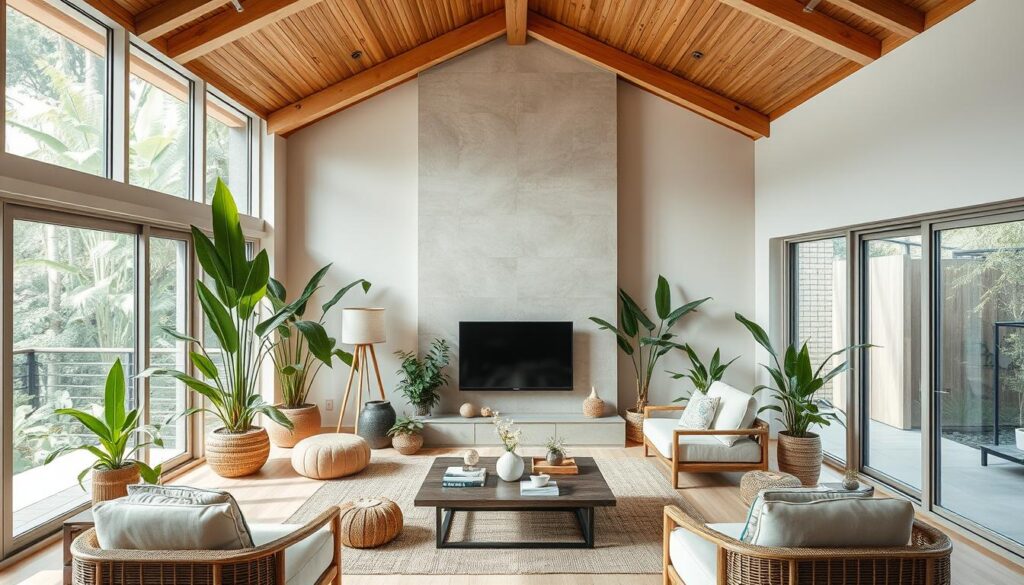
Choosing Sustainable Materials for Your Home
When you embark on creating an eco-friendly living space, the selection of materials plays a pivotal role. By choosing sustainable materials, you enhance green home interiors while minimizing your environmental footprint. Below are some key materials that contribute positively to sustainability.
Organic and Natural Textiles
Opting for organic and natural textiles is essential for a healthier environment. Fabrics like organic cotton and linen are produced without harmful pesticides and chemicals, offering a safer choice for your home. These materials not only promote sustainability but also add a touch of comfort to your décor.
Reclaimed Wood and Bamboo
Reclaimed wood and bamboo are fantastic options for sustainable interior furnishings. Reclaimed wood helps combat deforestation while providing unique character to your space. Bamboo grows exceptionally fast, making it one of the most renewable resources available. These materials significantly contribute to your eco-friendly living space by reducing waste and supporting the use of existing resources.
Low-VOC Paints and Finishes
Using low-VOC paints and finishes is crucial for maintaining indoor air quality. These products emit fewer volatile organic compounds, which can negatively impact health. By choosing finishes that are both environmentally friendly and appealing, you not only create a beautiful space but also ensure it remains conducive to well-being.

Incorporating these materials into your home aids in crafting an inviting and sustainable atmosphere, making it easier to enjoy eco-friendly living. Sustainable living should extend to all aspects of life, including the materials used in building homes8. Remember to consider the life-cycle carbon footprint of the materials you choose, as this is an effective way to measure their sustainability9.
The Role of Energy Efficiency in Eco-Friendly Interiors
Incorporating energy efficiency into your home design not only benefits the environment but also enhances your overall eco-friendly living space. By implementing smart technologies and energy-saving solutions, you can reduce your energy consumption while enjoying a beautiful and sustainable home.
Smart Lighting Solutions
Utilizing smart lighting solutions significantly reduces energy costs. LED lighting systems can reduce traditional energy costs by up to 80%, leading to substantial long-term savings for both residential and commercial interior designs10. Switching to LED lighting has also been shown to decrease monthly electricity expenses for businesses by around 30%10. Furthermore, smart lighting controls that are tailored to natural light patterns can result in a 25% reduction in overall energy usage within commercial environments10.
Energy-Efficient Appliances
Investing in energy-efficient appliances plays a critical role in creating an environmentally conscious home decor. These appliances are designed to minimize energy consumption, thereby lessening your carbon footprint. By selecting eco-friendly options, you contribute to healthier living and working environments by reducing the use of toxic materials11. For instance, sustainable plumbing fixtures can substantially cut water usage, complementing your energy-saving efforts.
Insulation and Windows
Proper insulation and energy-efficient windows are essential for maintaining indoor temperatures effortlessly. They not only enhance comfort but also decrease reliance on heating and cooling systems, which can lead to a greener and more sustainable living space. Low-VOC paints and finishes contribute significantly to indoor air quality, ensuring your eco-friendly living space remains healthy11. Together, these features transform your residence into an oasis of sustainability, promoting energy efficiency and environmental responsibility.
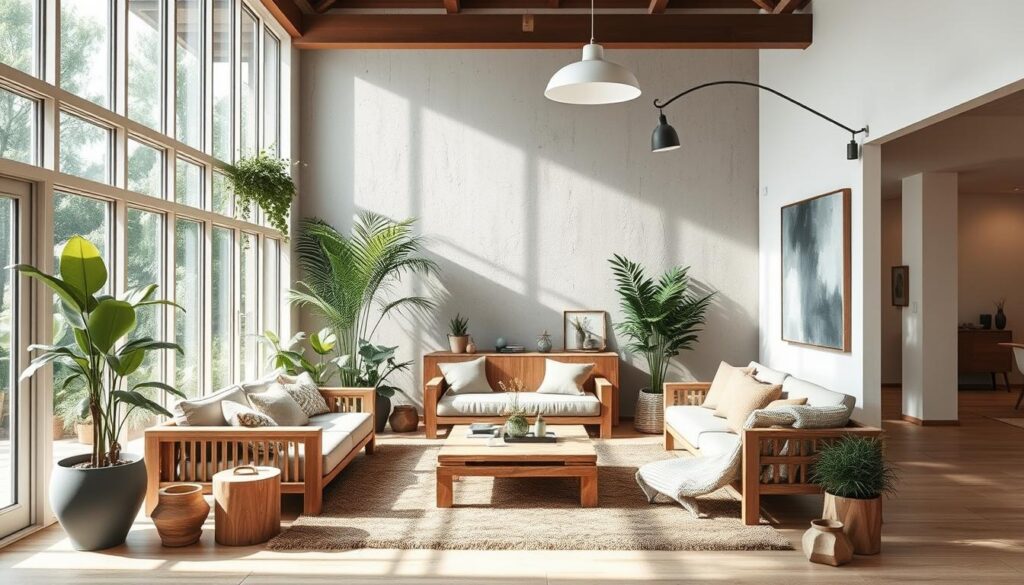
Incorporating Plants into Your Interior Design
Introducing plants into your interior design transforms your space while enhancing sustainability. A well-curated selection of air-purifying houseplants can significantly improve air quality; for instance, studies show that incorporating indoor plants boosts air quality by an impressive 25% among luxury homeowners1213. These plants not only filter toxins from the air but also release oxygen, contributing to a healthier indoor environment.
Air-Purifying Houseplants
Popular choices for air-purifying houseplants include snake plants and peace lilies, known for their efficiency in removing pollutants. Such plants are beneficial in eco-friendly living spaces, helping to create a more health-conscious atmosphere while embodying the principles of green home interiors.
Creating a Biophilic Design
Biophilic design effectively incorporates natural elements into home interiors, fostering a connection with nature. This design choice not only boosts aesthetic appeal but also improves your overall well-being and reduces stress levels13. The integration of greenery into your home aligns perfectly with sustainable interior furnishings, making your space both beautiful and beneficial.
Indoor Garden Ideas
Consider implementing indoor garden ideas such as vertical gardens or potted plants placed strategically to enhance their visual impact. These options not only beautify your ecosystem but also serve functional purposes, ensuring you create an environmentally-friendly indoor atmosphere. Using sustainable practices, including organic growing mediums and recycled containers, can further promote eco-friendly living spaces.

In conclusion, incorporating plants in your interior design is vital to achieving a sustainable and inviting atmosphere. As you choose the right plants and design elements, remember that these additions promote both eco-consciousness and the overall appeal of your living space, creating a harmonious blend of aesthetics and functionality1213.
The Importance of Upcycling in Home Décor
Upcycling is a creative solution to modern environmental challenges, transforming discarded items into unique, sustainable interior furnishings that reflect your personality. As the trend of sustainable interior design continues to grow, incorporating recycled materials through upcycling becomes essential for consumers seeking an eco-friendly living space.
Creative Upcycling Projects
Whether it’s converting old furniture or reimagining decorative pieces, there are countless opportunities for creative upcycling projects. For example, using antique drawer pulls and knobs alongside contemporary hardware enhances the charm of your décor while fostering a sustainable approach. Personal touches like reclaimed heritage items and family heirlooms add a connection to history, making your environmentally conscious home decor truly one-of-a-kind.
How Upcycling Reduces Waste
By reusing materials, upcycling significantly cuts down on waste, helping to minimize landfill accumulation. Refurbishing existing furnishings, such as reupholstering, saves costs associated with disposal and provides an environmentally-friendly alternative to buying new items. Statistics show that sustainable interior design practices utilizing recycled materials are on the rise, reflecting a shift towards consumer preferences for sustainable products aligned with their values14. Companies like RENEW by Trinity illustrate how innovative upcycling methods not only serve aesthetic needs but also bolster sustainability efforts by showing the impact of purchasing decisions15.
Finding Upcycled Furniture
Purchasing upcycled furniture can lead to discovering extraordinary options for your home. Locally sourced pieces bring economic and environmental benefits, as they reduce transportation emissions and foster local craftsmanship. Unique items, like those crafted from reclaimed chopsticks, highlight sustainability while offering a modern aesthetic that appeals to diverse tastes. As the popularity of upcycled items grows, they remain a staple in creating a stylish and eco-friendly living environment.
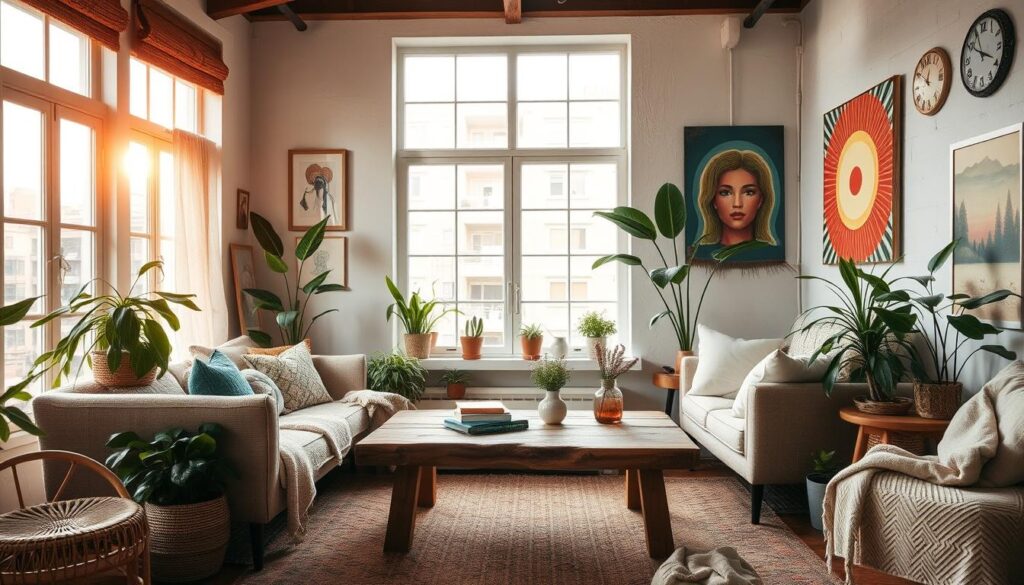
| Project Type | Description | Benefits |
|---|---|---|
| Furniture Refurbishing | Reupholstering old furniture with fresh fabric | Cost-effective and environmentally friendly |
| Decorative Repurposing | Transforming everyday items into home decor | Unique pieces that reflect personality |
| Using Reclaimed Materials | Building items with salvaged wood or metal | Reduced environmental footprint |
| Antique Incorporation | Mixing vintage finds with new designs | Rich history and character in decor |
By embracing upcycling in your home, you contribute to sustainable practices while creating a personalized, eco-friendly living space that speaks to your values14.
Sustainable Furniture Choices
When embarking on your journey towards an eco-conscious home, selecting sustainable furniture choices is essential. By prioritizing local and artisan brands, you not only support small businesses but also significantly reduce the carbon footprint associated with long-distance transportation. In the realm of sustainable interior furnishings, this practice aligns with the principles of green home interiors.
Choosing Local and Artisan Brands
Opting for local and artisan brands ensures that common materials are sourced responsibly. Sustainable furniture often requires less energy to produce and transport, contributing to a lower carbon footprint16. These brands usually emphasize eco-conscious design concepts that incorporate reclaimed wood, bamboo, and jute, which are durable, biodegradable options that promote sustainability16.
Multi-Functional Furniture
Multi-functional furniture maximizes space while minimizing consumption. Such designs not only enhance the functionality of your space but also reflect an understanding of resource efficiency17. Investing in versatile pieces helps you transition effortlessly between daily needs while maintaining a commitment to sustainable practices. Vintage and upcycled options provide uniqueness while reducing landfill waste16.
Sustainable Upholstery Options
Sustainable upholstery options are vital to creating a healthy living space. Materials like organic cotton, hemp, and wool help reduce exposure to volatile organic compounds (VOCs), contributing to improved indoor air quality16 and16. Choosing finishes that emit low VOCs further enhances your home environment, reflecting an adherence to sustainable practices. Supporting local artisans who prioritize sustainability fosters community engagement while minimizing environmental impact.
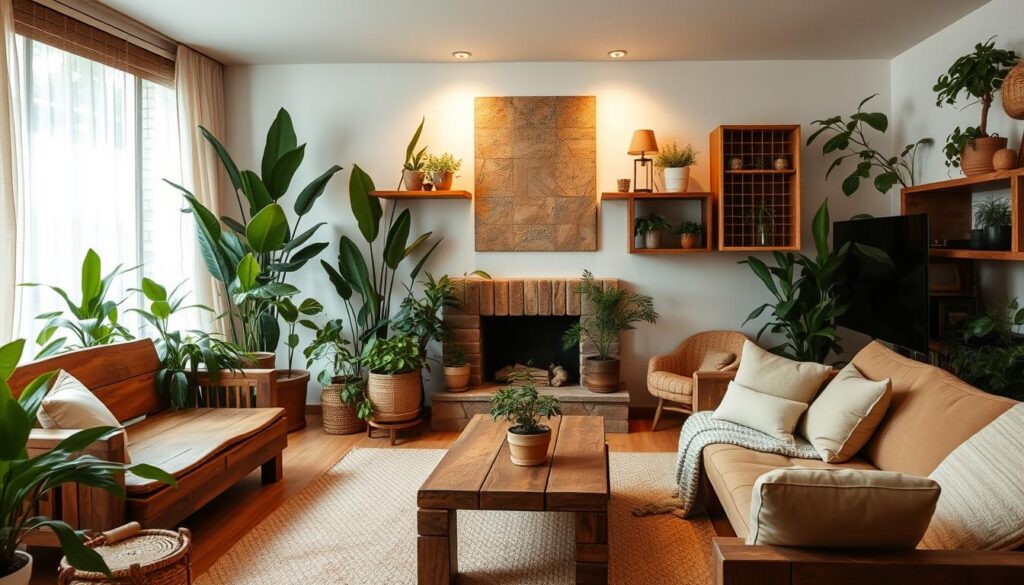
| Material | Benefits |
|---|---|
| Bamboo | Rapid renewability and strength |
| Reclaimed Wood | Prevents new tree harvesting |
| Hemp | Fast-growing and resource-efficient |
| Jute | Durable and biodegradable |
| Low-VOC Finishes | Improve indoor air quality |
By integrating these sustainable furniture choices, you create a space that is not only aesthetically pleasing but also aligned with eco-friendly principles. The combination of local sourcing, multifunctional designs, and sustainable upholstery contributes to a healthier environment and promotes responsible living17.
Crafting an Eco-Friendly Color Palette
Creating an eco-friendly color palette is essential in transforming your living space into a serene haven that reflects nature’s beauty. By choosing earthy tones and natural colors, you can foster a calming environment that enhances your well-being. Colors inspired by natural elements, such as greens, browns, and blues, contribute to a cohesive green interior design that aligns with sustainable practices18.
Earthy Tones and Natural Colors
Utilizing colors like earthy neutrals and ocean-inspired hues can create a balanced ambiance. Incorporating reclaimed wood details adds warmth and texture while promoting sustainable interior furnishings. The calming qualities of these colors not only beautify your home but also connect it with the surrounding environment, fostering an eco-friendly living space.
Paint Options with Low Environmental Impact
Selecting paints with low VOC or zero VOC content is vital for maintaining healthy indoor air quality19. Such options help minimize harmful emissions while ensuring your home remains both vibrant and safe. With careful choices in colors and materials, you can significantly reduce environmental impact, exemplifying a commitment to eco-friendly practices20.

| Color Palette Type | Color Examples | Materials |
|---|---|---|
| Kitchen | Natural Greens, Earthy Neutrals | Recycled Glass, Reclaimed Wood |
| Bedroom | Soft Blues, Natural Whites | Bamboo, Organic Cotton |
| Home Office | N/A | N/A |
Your choices in color play an essential role in establishing a sustainable aesthetic. By integrating these elements, you not only enhance your space but also contribute positively to the environment20.
Implementing Smart Technology for Sustainability
In today’s world, integrating smart technology into home design is crucial for fostering sustainability and enhancing efficiency in your living space. This approach not only promotes an environmentally conscious home decor but also supports the use of sustainable interior furnishings, creating a harmonious atmosphere.
Smart Thermostats and Energy Monitoring
Smart thermostats play a significant role in regulating heating and cooling, ensuring energy consumption is minimized without sacrificing comfort. These devices learn your patterns, adjusting settings to optimize energy usage while keeping your eco-friendly living space comfortable. Energy monitoring systems provide valuable insights by tracking consumption, allowing you to identify areas for improvement21 and make choices that align with sustainable goals.
Home Automation for Eco-Friendly Living
Home automation enhances eco-friendly living by allowing you to manage energy use effectively through interconnected devices. For instance, timed lighting controls help you reduce waste by ensuring lights are only used when necessary. The Internet of Things (IoT) facilitates seamless communication between various smart devices, enabling efficient automation tailored to your lifestyle22. This integration not only creates a modern living environment but also supports the values of sustainable interior furnishings and mindful energy consumption.
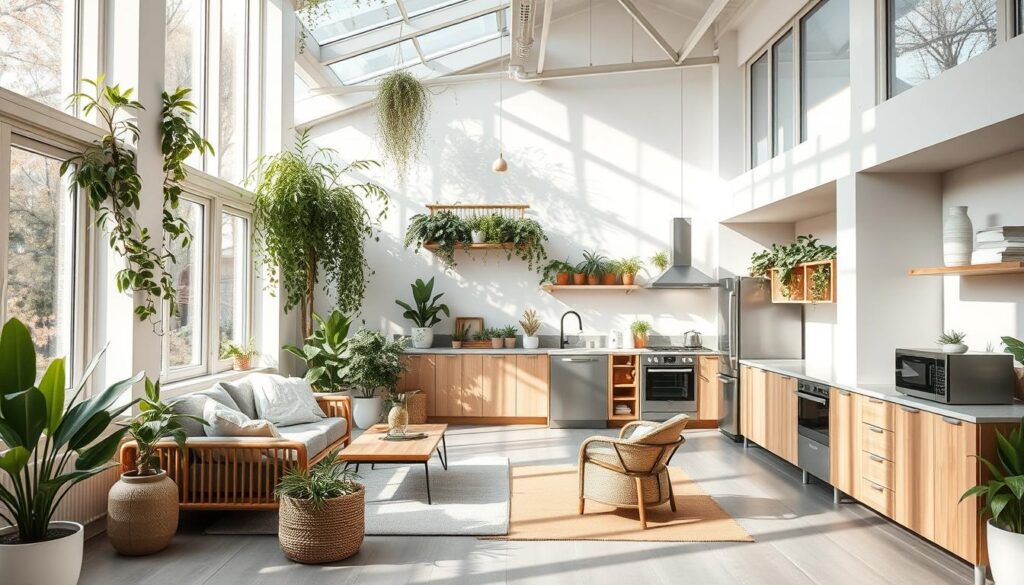
| Smart Technology | Benefits |
|---|---|
| Smart Thermostats | Regulate temperature and reduce energy costs |
| Energy Monitoring Systems | Provide insights into usage and identify savings |
| Home Automation | Streamline energy use and enhance comfort |
By implementing smart technology, you contribute to a more sustainable and eco-friendly living space, ultimately positioning yourself at the forefront of the green home movement21.
Tips for Sustainable Lighting Design
Creating a sustainable lighting design is critical for achieving an eco-friendly living space while enhancing your home’s ambiance. By utilizing natural light wherever possible, you can maximize the beauty of your interior without relying heavily on artificial lighting. In fact, approximately 15% of the annual electrical consumption in homes is attributed to lighting23. Hence, adopting energy-efficient solutions can significantly lower this figure.
Using Natural Light to Your Advantage
Optimizing natural light in your design helps to improve mood and reduce energy consumption. Incorporating large windows, skylights, and open floor plans facilitates the free flow of light throughout your home. These strategies not only contribute to sustainable interior furnishings but also cut down on the need for artificial lighting during the day.
Energy-Saving Light Bulbs
When it comes to artificial lighting, energy-saving light bulbs are a must-have. LED technology, for example, uses at least 75% less energy compared to traditional incandescent lighting and lasts up to 25 times longer24. Switching to LED bulbs can yield savings of up to 50% on energy usage and reduce lighting energy consumption by up to 70%2325. Dimmers also enhance energy efficiency by extending the life of your bulbs while providing flexible lighting options.
Eco-Friendly Lighting Fixtures
Choosing eco-friendly lighting fixtures is crucial for aligning with green interior design principles. Many sustainable vendors, such as Graypants and Varaluz, offer lighting solutions made from recycled materials and implement green practices24. Consider incorporating dimmable LED lights as they not only reduce energy use but also provide mood-setting capabilities, enhancing your overall living environment25.

| Lighting Types | Energy Consumption | Longevity |
|---|---|---|
| Incandescent Bulbs | 100% energy use | 1,000 hours |
| CFL Bulbs | Approximately 66% energy savings | 7,000 hours |
| LED Bulbs | Up to 75% energy savings | 15,000 to 25,000 hours |
By implementing these tips, you create a sustainable interior that not only looks beautiful but also respects the environment, contributing to a greener future24.
Creating a Sustainable Kitchen
Creating a sustainable kitchen is an essential aspect of developing an eco-friendly living space. This involves choosing energy-efficient appliances, selecting eco-friendly countertops, and implementing composting solutions. Each element contributes positively to environmentally conscious home decor while promoting a healthier, more sustainable lifestyle.
Sustainable Kitchen Appliances
Your choice of kitchen appliances greatly affects energy consumption. Energy Star appliances are preferable for reducing daily energy use, with estimates indicating that a typical household using these appliances can save $450 on their energy bills annually26. Sustainability keeps evolving, with more than 60% of agents and brokers finding energy efficiency to be a strong selling point in listings26. Induction cooktops are a prime example, as they are up to 10% more efficient than electric and 300% more efficient than gas options26. Many manufacturers now offer sustainable kitchen appliances that focus on eco-friendly manufacturing and packaging, enhancing brand reputation among conscious buyers26.
Eco-Friendly Countertops
Countertops can significantly influence the aesthetics of your kitchen while maintaining sustainability. Options like recycled glass counters are resistant to heat and stains, providing durability and aesthetic appeal27. Bamboo is another excellent choice; it’s renewable and often affordable for eco-friendly kitchen cabinets27. For those who prefer natural stone, soapstone countertops are non-porous, avoiding the need for harsh stains or cleaners27. Other materials like linoleum, made from linseed oil and ground limestone, showcase the variety available for a greener kitchen design27.
Composting Solutions in the Kitchen
Encouraging waste reduction through composting is a vital step in any sustainable kitchen. It not only diverts organic waste from landfills but also enriches your garden soil, ensuring sustainability extends beyond your kitchen. By integrating composting solutions, you support eco-friendly processes while promoting efficient waste management in your home.

Sustainable kitchens can lead to a positive buyer perception, providing a worthwhile investment for homeowners looking to enhance their home’s value.26
Eco-Friendly Bathroom Renovations
Transforming your bathroom into an eco-friendly living space begins with a focus on reducing water consumption and utilizing sustainable materials. This approach not only benefits the environment but also enhances the overall functionality and aesthetics of your green home interiors.
Water-Saving Fixtures
Installing water-saving fixtures can significantly decrease your household’s water usage. For instance, low-flow toilets can use up to six liters less water per flush compared to regular toilets28. Approximately 24% of a household’s water use can be attributed to the toilet29. Similarly, opting for low-flow showerheads and faucets can lead to substantial savings in both water and energy costs29, with about 20% of water usage in households stemming from showers29.
Sustainable Bathroom Materials
Choosing sustainable bathroom materials is crucial in achieving a genuinely eco-friendly space. Responsible sourcing of wood for bathroom cabinets can yield lower greenhouse gas emissions28. Strawboard cabinets have emerged as a popular eco-friendly alternative to medium density fiberboard (MDF) cabinets28. Moreover, clay ceramic tiles are not only sustainable but also compostable, being a natural material drawn from the earth28. For adhesives, companies like Kerakoll provide mineral adhesives for ceramic and natural stone tiles, presenting environmentally friendly options for your renovation28.
An exciting trend is mixing brand-new fixtures with repurposed antique bathroom furniture, which not only adds character but also reduces waste28. When selecting paints, consider eco-friendly options that feature low volatile organic compounds (VOCs), as they contribute to reducing indoor air pollution29. Lastly, integrating muted colors in your bathroom’s design can complement sustainable fixtures and fittings, creating a harmonious look that emphasizes your commitment to eco-friendly living28.

The Importance of Proper Waste Management
Emphasizing proper waste management is essential in establishing a sustainable interior furnishings approach within your home. This not only helps in creating an eco-friendly living space but fosters environmentally conscious home decor. You can implement effective waste management strategies to significantly enhance your green efforts.
Recycling and Composting in Your Home
Start by setting up a clear recycling system that allows you to sort materials efficiently. This helps to divert waste from landfills and repurpose materials, promoting sustainability in your home. Composting is another effective method, enabling you to reduce food waste while enriching your garden soil, thus supporting a greener environment.
Reducing Single-Use Items
Reducing single-use items is crucial in maintaining an eco-friendly living space. Aim to replace plastic bags and disposable containers with reusable alternatives. By making these simple swaps, you encourage more sustainable habits and make environmentally conscious choices in your daily life. Every effort counts towards a healthier planet and enhanced sustainability in your home decor.
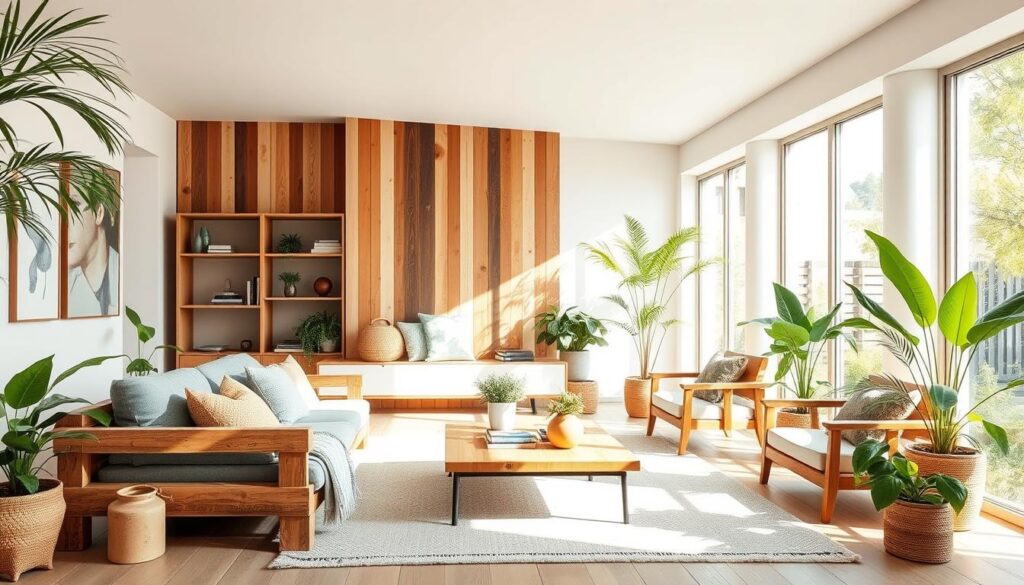
Tips for Maintaining an Eco-Friendly Home
Creating and maintaining an eco-friendly living space requires regular attention to ensure that sustainability practices are continuously upheld. Regular check-ups on your energy and water usage can highlight areas for improvement, contributing to a more environmentally conscious home decor.
Routine Check-Ups for Sustainability
Establishing a routine for checking the efficiency of your home can enhance your eco-friendly living space. Take the time to assess your energy consumption, water usage, and overall environmental impact. Simple adjustments, like replacing incandescent bulbs with energy-efficient LED lights, can lead to a reduction in energy consumption by up to 75%, offering both sustainability and cost savings30. Monitoring appliances ensures they operate at peak efficiency, which helps reduce your carbon footprint and uphold sustainable interior furnishings.
Sustainable Cleaning Products
Maintaining a clean home should not come at the expense of environmental health. Opt for sustainable cleaning products made from natural and non-toxic ingredients. These options minimize harmful chemicals that often compromise indoor air quality while promoting a healthier environment30. By choosing low-VOC or zero-VOC paints and cleaners, instances of indoor air pollution can be decreased by up to 75%, supporting your ongoing commitment to eco-friendly living31. Embracing sustainable cleaning practices not only contributes to an environmentally friendly home, but also fosters the maintenance of a safe and welcoming atmosphere.
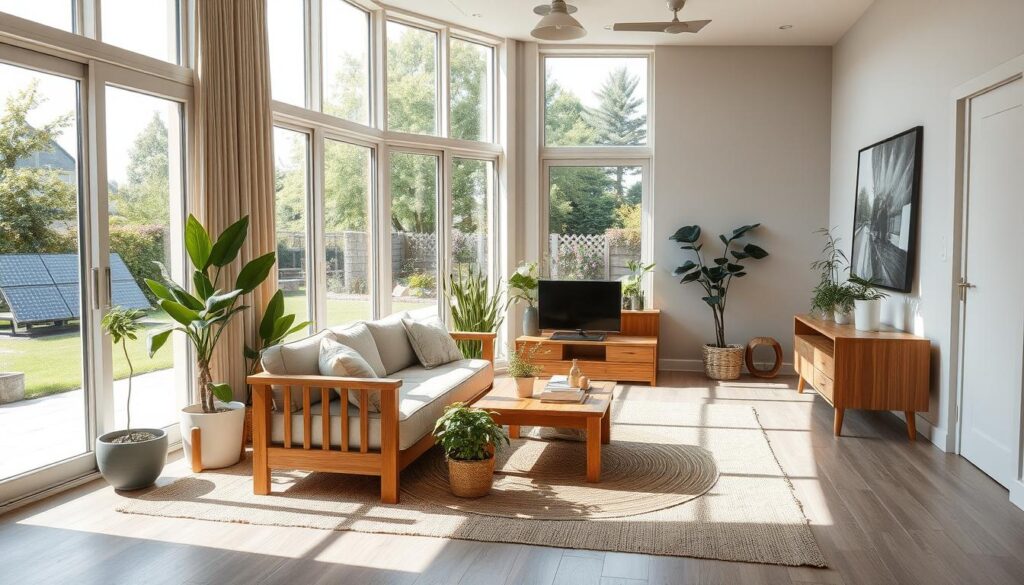
Future Trends in Sustainable Interior Design
The landscape of sustainable interior design is evolving rapidly, driven by a range of innovations and practices aimed at creating environmentally conscious home decor. With the growing awareness of ecological footprints, designers are increasingly incorporating natural fibers such as organic cotton, linen, and wool into their creations, making them integral to sustainable interior furnishings. Furthermore, the utilization of recycled materials like reclaimed wood and recycled metals is becoming a standard in eco-friendly designs, aligning with the overarching goal of reducing environmental impact while enhancing aesthetic value3233.
Innovations in Eco-Friendly Materials
The techniques employed in modern design are also evolving, with a focus on biophilic design principles that emphasize the incorporation of natural elements like plants and water features into interiors34. In 2024, the palette leans heavily towards earthy tones combined with vibrant accents to create spaces that feel both fresh and grounded. Additionally, eco-friendly materials, such as vegan leather and handwoven rugs, are not just favored for their sustainability but also for the character they lend to living environments32.
The Growth of Green Certifications
Alongside these material innovations is the significant rise in green certifications, which guide homeowners in making informed decisions about their spaces. As these certifications become more prevalent, they push for responsible sourcing and the adoption of low-VOC paints that promote healthier indoor settings3334. These trends not only encourage sustainable practices but also work to shape a future where green home interiors become the norm, allowing you to create a stylish oasis that embodies sustainability while reflecting your personal taste.
FAQ
What are the main benefits of sustainable interior design?
How can I choose sustainable materials for my home decor?
What role does energy efficiency play in sustainable interiors?
How can I maintain a sustainable kitchen?
Why is upcycling important in home decor?
What are some eco-friendly lighting solutions I can use?
How can I incorporate plants into my interior design?
What should I consider when selecting furniture?
How can I create an eco-friendly color palette for my home?
What practices can I implement for proper waste management at home?
How can I maintain my eco-friendly home?
What future trends should I be aware of in sustainable interior design?
Source Links
- https://www.sustainablejungle.com/sustainable-interior-design/ – Sustainable Interior Design: Create Your Own Eco-Styled Home
- https://illustrarch.com/articles/architectural-sustainability/35188-sustainable-interior-design-transform-your-family-home.html?srsltid=AfmBOorccR9ylUhNWyvqpzySE-ySUsOMTDG8uKNDJLBNpCAe4wMRlVbJ – Transform Your Family Home with Sustainable Interior Design: Eco-Friendly Tips | illustrarch
- https://www.portaire.com/journal/sustainable-materials-that-dont-compromise-design – Sustainable Materials for Interior Design: A Guide
- https://www.rmcad.edu/blog/sustainable-interiors-materials-practices-and-design-philosophy/ – Sustainable Interiors: Materials, Practices and Design Philosophy – RMCAD
- https://biofilico.com/news/top-tips-sustainable-interior-design-tech-eco-friendly – Sustainable interior design integrating technology in eco-friendly spaces — wellness design consultants
- https://www.augmentecture.com/blog/sustainability-in-interior-design/ – Sustainability in Interior Design: Strategies & Advantages – AUGmentecture Blog
- https://econyl.medium.com/5-principles-of-sustainable-interior-design-b390503a5176 – 5 Principles of Sustainable Interior Design
- https://ecoshack.com/sustainable-interior-design/ – The ultimate guide to sustainable interior design.
- https://houses.eyrc.com/blog/sustainable-interior-materials – Sustainable Interior Materials: Designing an Eco-Friendly Home
- https://thewhiteframe.com/green-energy-efficient-interior-design-5-ways/ – Energy Efficient Interior Design- 5 Tips On Sustainability
- https://primera.net/home-interiors/sustainability-in-interior-design/ – Sustainability in Interior Design: Eco-Friendly Solutions | Primera
- https://cihdesign.com/elegant-interiors-with-sustainable-materials/ – Elegant Interiors with Sustainable Materials
- https://www.exubia.co.uk/creating-eco-friendly-interiors-a-guide-to-biophilic-design/ – Creating Eco-Friendly Interiors: A Guide to Biophilic Design | Exubia
- https://www.carolinaspaces.com/home/sustainable-design-repurposed-and-upcycled-materials-create-unique-looks-for-every-room – Sustainable Design – Repurposed and Upcycled Materials Create Unique Looks for Every Room – Carolina Spaces
- https://nyweekly.com/business/energy-and-upcycling-in-home-decor/ – The Rise of Renewable Energy and Upcycling in Home Décor
- https://www.theinteriordesigninstitute.com/us/en/blog-eco-friendly-furniture-guide – The Interior Design Institute
- https://www.thegoodtrade.com/features/eco-friendly-furniture-brands-for-a-stylish-and-conscious-home/ – 9 Eco And Sustainable Furniture Companies In 2025
- https://www.linkedin.com/advice/3/what-some-examples-sustainable-color-palettes-different-h3w3c – What are some examples of sustainable color palettes for different interior spaces?
- https://stewartlighting.com/2024/08/09/eco-friendly-interior-design-5-tips-for-a-sustainable-and-stylish-home/ – Eco-Friendly Interior Design: 5 Tips For a Sustainable and Stylish Home | Stewart Lighting
- https://ecofriend.com/sustainable-living-and-interior-design-creating-mindful-spaces.html – Sustainable Living and Interior Design: Creating Mindful Spaces – Ecofriend
- https://ruralhandmade.com/blog/embracing-the-future-the-intersection-of-technology-and – Embracing The Future: The Intersection Of Technology And Sustainable, Accessible Interior Design
- https://illustrarch.com/articles/26957-sustainable-architectural-solutions-for-smart-homes.html?srsltid=AfmBOory258hhz-NS6nJXjtUzNSXmDvmXz_qoS_nhfZWz0AeIV-9wcIW – Sustainable Architectural Solutions for Smart Homes | illustrarch
- https://perfectpicturelights.com/blog/tips-for-sustainable-lighting-design-in-your-home?srsltid=AfmBOopMm4MDriIqNA8VV9yuR1czwtUNPJwlgoFqQFk1XCo2tqJ4tagK – Tips for Sustainable Lighting Design In Your Home
- https://www.lightology.com/index.php?module=how_to&sub=sustainable-lighting-tips&srsltid=AfmBOopxBE_dhx3NmY5GjCu7HHtKYZpQe1RRrmtp_zlixC7UAQw7SckV – 9 Green Tips for Sustainable Lighting – Lightology
- https://www.tcpi.com/exploring-eco-friendly-sustainable-lighting-solutions/ – Exploring Sustainable Lighting Solutions – TCP Lighting
- https://www.nar.realtor/magazine/real-estate-news/home-and-design/sustainable-spaces-the-kitchen – Sustainable Spaces: The Kitchen
- https://www.bkckitchenandbath.com/planning-a-sustainable-kitchen-with-eco-friendly-materials/ – Sustainable Kitchen Design with Eco-Friendly Materials | BKC
- https://riluxa.com/blog/design-trends-3/sustainable-bathroom-design-a-guide-to-eco-friendly-remodeling-270?srsltid=AfmBOooia2_k4K2R14fq-DePPQABzR1NEuI53lJXlQvAVpKoH4Hw9mbY – Sustainable Bathroom Design: A Guide to Eco-Friendly Remodeling
- https://www.nar.realtor/magazine/real-estate-news/home-and-design/sustainable-spaces-the-bathroom – Sustainable Spaces: The Bathroom
- https://kreativedgeinteriors.com/sustainable-interior-design-tips-for-an-eco-friendly-home/ – Sustainable Interior Design Ideas for an Eco-Friendly Home
- https://metercube.com/blog/eco-friendly-interiors-and-sustainable-design-tips/?srsltid=AfmBOoqLN0G2n9KVbgP7G4Sjz9mEaaIbe87jQ5bKUHv8hcn463L3ritE – Eco-friendly Interiors: Sustainable Design Tips for a Greener Home
- https://mischmisch.com/articles/eco-conscious-luxury-the-future-of-sustainable-interior-design/ – Eco-Conscious Luxury: The Future of Sustainable Interior Design • misch_MISCH studio
- https://foscariinteriors.com/2024/05/15/interior-design-trends-2024 – Renew your home with our cabinet customization – Foscari Interiors
- https://blogs.ed.ac.uk/s2465333_environmental-design-materials-ecologies-futures-2023-2024sem1/2023/11/20/embracing-the-future-top-emerging-trends-in-eco-friendly-interior-design/ – Embracing the Future: Top Emerging Trends in Eco-Friendly Interior Design



